
THE SNAKE PIT
[RKO horror unit under the direction
of Val Lewton]
Here are a few of its denizens:
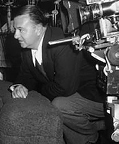 director, Jacques
Tourneur (1904-1977) director, Jacques
Tourneur (1904-1977)
for
Lewton:
Cat People (1942), I Walked with a Zombie (1943), The
Leopard Man (1943)
also:
Experiment Perilous (1944), Out of the Past (1947), Berlin
Express (1948), The Flame and the Arrow (1950), Nightfall (1957), Night
of the Demon (1957), The Comedy of Terrors (1964)
Son
of French director Maurice Tourneur. After his sympatico
partnership with Lewton, he went on to make Out of
the Past and Night of the Demon, classics
in their respective genres |
|

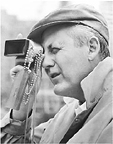 director, Robert
Wise (1914-2005) director, Robert
Wise (1914-2005)
for
Lewton:
Mademoiselle Fifi (1944), The Curse of the Cat People (1944), The
Body Snatcher (1945)
also:
Born to Kill (1947), Blood on the Moon (1948), The
Set-Up (1949), The Day the Earth Stood Still (1951), Somebody
Up There Likes Me (1956), Run Silent Run Deep (1958), Odds
Against Tomorrow (1959), West Side Story (1961), The
Haunting (1963), The Sound of Music (1965), The
Sand Pebbles (1966), The
Andromeda Strain (1971)
Became
one of Hollywood's most successful directors, with a long and
varied career. The man who did The Sound of Music also
did the tough claustrophobic boxing movie, The Set-Up.
For this reason, not a favorite with auteurists. |

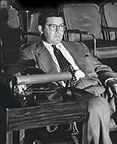 director, Mark
Robson (1913-1978) director, Mark
Robson (1913-1978)
for
Lewton:
The Seventh Victim (1943), The Ghost Ship (1943), Youth
Runs Wild (1944), Isle of the Dead (1945), Bedlam (1946)
also:
Champion (1949), Bright Victory (1951), The Bridges
at Toko-Ri (1954), The
Harder They Fall (1956), Peyton Place (1957), The
Inn of the Sixth Happiness (1958), Von Ryan's Express (1965), Valley
of the Dolls (1967), Earthquake (1974)
Born
in Montreal. Editor with Orson Welles and then Lewton. Like Wise,
he managed a long, successful, though less-celebrated, career.
His output defies any attempt at classification, going from war
movie
to
soap opera
in the blink
of an eye. |

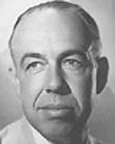 music, Roy
Webb (1888-1982) music, Roy
Webb (1888-1982)
for
Lewton:
Cat People (1942), I Walked with a Zombie (1943), The
Leopard Man (1943), The Seventh Victim (1943), The
Ghost Ship (1943), The Body Snatcher (1945), Bedlam (1946)
also:
Bringing Up Baby (1938), My Favorite Wife (1940), Stranger
on the Third Floor (1940), Journey Into Fear (1943), The
Fallen Sparrow (1943), Murder, My Sweet (1944)
, Experiment Perilous (1944), Cornered (1945), The
Spiral Staircase (1945), Notorious (1946), The
Locket (1946), It's a Wonderful Life (1946), The
Devil Thumbs a Ride (1947), Crossfire (1947), Out
of the Past (1947), Blood on the Moon (1948), The
Window (1949), The Racket (1951), Clash by
Night (1952), The Lusty Men (1952), Angel Face (1952), Track
of the Cat (1954), Marty (1955)
Webb
came to the movies well grounded in classical music as well as
Broadway show tunes. He had worked with Richard Rogers and Max
Steiner. Though he could handle comedy like Bringing Up Baby,
it was when he brought his "advanced harmonies and melancholy
fatalism" to " the brooding psychological thrillers that
were RKO’s specialty in the 1940s" (Naxos), that he
made his most indelible mark. |

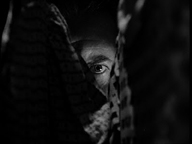 camera, Nicholas
Musuraca (1892-1975) camera, Nicholas
Musuraca (1892-1975)
for
Lewton:
Cat People (1942), The Seventh Victim (1943), The
Ghost Ship (1943), The Curse of the Cat People (1944), Bedlam (1946)
also:
Golden Boy (1939), Stranger on the Third Floor (1940), The
Fallen Sparrow (1943), The Spiral Staircase (1945), The
Locket (1946), Out of the Past (1947), I Remember
Mama (1948), Blood on the Moon (1948), Where
Danger Lives (1950), Clash by Night (1952), The
Blue Gardenia (1953), The Hitch-Hiker (1953)
Born
in Italy. He is one of the primary shapers of noir with his fearless
use of black. He shot Stranger on the Third Floor (1940),
a contender for first-noir-movie status. "The low placement
of light sources - often in the guise of table lamps, but also
fireplaces and campfires - netted a highly expressionistic look
as the illuminated subject was trapped by his or her own shadow
looming on the walls and ceiling above." (Eric Schaefer, Film
Reference) |

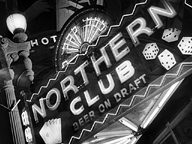 camera, Robert
DeGrasse (1900-1971) camera, Robert
DeGrasse (1900-1971)
for
Lewton:
The Leopard Man (1943), The Body Snatcher (1945)
also:
The Outcasts of Poker Flat (1937), Stage Door (1937), Crack-Up (1946), Born
to Kill (1947), The Window (1949), The Men (1950)
Came
from a family involved in the early days of movies. Was a cinematographer
at 21, having been a camera operator. With the advent of sound,
he went back to being an operator and once again worked his way
to cinematographer by learning the details of the new medium. |

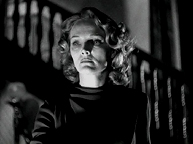 actress, Elizabeth
Russell (1916-2002) actress, Elizabeth
Russell (1916-2002)
for
Lewton:
Cat People (1942), The Seventh Victim (1943), The
Curse of the Cat People (1944), Youth Runs Wild (1944), Bedlam (1946)
also:
The Corpse Vanishes (1942), Hitler's Madman (1943), A
Scream in the Dark (1943),
Weird Woman (1944), Our
Vines Have Tender Grapes (1945)
A
successful fashion model before turning to film, she became
a consumate character actor. Her roles for Lewton were
small, but in each she was a magnetic presence. It's quite
sad that she didn't go on to have a glorious career. |

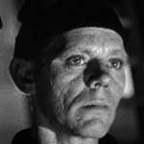 actor, Skelton
Knaggs (1911-1955) actor, Skelton
Knaggs (1911-1955)
for
Lewton:
The Ghost Ship (1943), Isle of the Dead (1945), Bedlam (1946)
also:
The Lodger (1944), The Picture of Dorian Gray (1945), Terror
by Night (1946), The Paleface (1948), Casanova's
Big Night (1954), Moonfleet (1955)
Born
in England, Shakespearean training. His career was largely
made of sinister roles, though Lewton seemed to see him in
a sympathetic light and used him accordingly, particularly
in The Ghost Ship. |

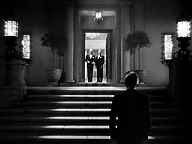 art
director, Albert S. D'Agostino (1892-1970) art
director, Albert S. D'Agostino (1892-1970)
all
of Lewton’s RKO output.
also:
The Raven (1935), Journey Into Fear (1943), The
Fallen Sparrow (1943), Murder, My Sweet (1944), Cornered (1945), The
Spiral Staircase (1945), The Stranger (1946), Notorious (1946), The
Locket (1946), The Devil Thumbs a Ride (1947), Born
to Kill (1947), Crossfire (1947), Out of the
Past (1947), Berlin Express (1948), Blood on
the Moon (1948), The Set-Up (1949), The Window (1949),
The Thing (1951), His Kind of Woman (1951), The
Racket (1951), On Dangerous Ground (1952), Macao (1952), The
Narrow Margin (1952), Clash by Night (1952), The
Lusty Men (1952), Angel Face (1952), The Hitch-Hiker (1953), Run
of the Arrow (1957)
New
Yorker Albert D'Agostino journeyed to Hollywood in the '20s to
seek work as an art director, and freelanced for many different
studios as a set decorator and art department technician before
he found his niche at RKO, where he stayed for the rest of his
career. D'Agostino was one of those responsible for the glossy
but gritty look of RKO's productions, and he collaborated on or
supervised the art direction of every RKO film. - IMDb |

 writer, DeWitt
Bodeen (1908-1988) writer, DeWitt
Bodeen (1908-1988)
for
Lewton:
Cat People (1942), The Seventh Victim (1943), The
Curse of the Cat People (1944)
also:
The Enchanted Cottage (1945), I Remember Mama (1948), Billy
Budd (1962)
Began
his career as an actor and playwright. Was Aldous Huxley's research
assistant for Jane Eyre. Did screenplays for RKO, and
eventually wrote for television as well as authoring articles and
books on film. |

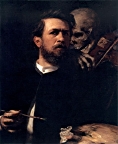 Lewton
was interested in paintings with a macabre bent and had a number
of famous works reproduced for use in the titles or on the sets
of his movies. Here (click left) are three that played a significant
thematic role in his oevre. Lewton
was interested in paintings with a macabre bent and had a number
of famous works reproduced for use in the titles or on the sets
of his movies. Here (click left) are three that played a significant
thematic role in his oevre.
|
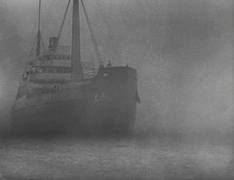
|

 director, Jacques
Tourneur (1904-1977)
director, Jacques
Tourneur (1904-1977)
 director, Robert
Wise (1914-2005)
director, Robert
Wise (1914-2005) director, Mark
Robson (1913-1978)
director, Mark
Robson (1913-1978) music, Roy
Webb (1888-1982)
music, Roy
Webb (1888-1982) camera, Nicholas
Musuraca (1892-1975)
camera, Nicholas
Musuraca (1892-1975) camera, Robert
DeGrasse (1900-1971)
camera, Robert
DeGrasse (1900-1971) actress, Elizabeth
Russell (1916-2002)
actress, Elizabeth
Russell (1916-2002) actor, Skelton
Knaggs (1911-1955)
actor, Skelton
Knaggs (1911-1955) art
director, Albert S. D'Agostino (1892-1970)
art
director, Albert S. D'Agostino (1892-1970) writer, DeWitt
Bodeen (1908-1988)
writer, DeWitt
Bodeen (1908-1988)

